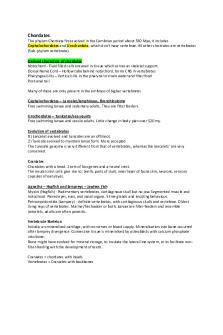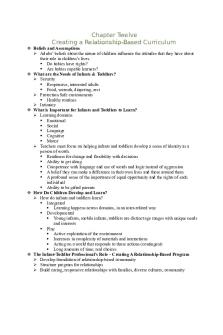Chapter 12 - Lecture notes 12 PDF

| Title | Chapter 12 - Lecture notes 12 |
|---|---|
| Course | Studio Art and Visual Culture |
| Institution | University of Louisville |
| Pages | 4 |
| File Size | 56.7 KB |
| File Type | |
| Total Downloads | 90 |
| Total Views | 205 |
Summary
lecture notes from prof Betty Alvarez...
Description
Chapter 12 Sculpture Learning Objectives - Compare examples of freestanding, low-relief, and high-relief sculpture. - Describe modeling, casting, carving, and constructive techniques used to make sculpture. - Define and describe kinetic sculpture. - Explain the parameters and components of mixed media sculpture. - Discuss artists’ use of installation and site-specific art to transform their surroundings. Introduction Martin Puryear, C.F.A.O. - Unpainted stack of wood on one side - Large, curving shape based on an elongated African mask on the other Freestyle and Relief Sculpture Sculpture is a work in three dimensions. - Height, breadth, depth - Experience existing in space - Two main types: freestanding and relief Freestanding or in-the-round - Sculpture meant to be seen from all sides Relief - Sculpture projects from a background surface - Low-relief (bas relief) - Slight projection - The Apollo coin - Temple complex of Angkor Wat, the center of Khmer empire in 12th century - Army on the March - Delicate low-relief carving - High-relief - More than half of the natural circumference projects from surface - Corporate Wars: Wall of Influence Methods and Materials Modeling - An additive process of building up material such as clay, wax, or plaster - Ballplayer with Three-Part Yoke and Bird Headdress - Naturalistic clay sculpture - Fingerprint impressions visible - Armature - A rigid inner support under soft materials - Auguste Rodin, Naked Balzac - Small armature - Gradually added plaster - When plaster dried, he removed the armature - Ken Price, Vink - Non-representational - Clay layered in acrylic paint - Mysterious, iridescent quality
Casting - Process involving the substitution of one material for another - Developed in ancient China, Greece, parts of Africa - Used extensively in the West from Renaissance times - Steps - Mold taken from original work - Completely surrounds the original - Original sculpture removed from the mold - May require disassembly - Casting liquid poured into mold cavity - Mold removed when liquid hardens - Lost-wax process - Mold only used once and destroyed to remove the hardened cast - Solid or hollow - Many items other than art are cast. - Engine parts, dishes, children’s toys - Charles Ray, Father Figure - Based on green plastic toy tractor - Enlarged to life-size - Cast in solid steel, weighs more than 18 tons - Duane Hanson - Cast actual people - Silicone rubber applied to skin - Cut cast away - Painted skin tones, added human hair and clothing - Man with Camera - Jolt of realism - Rachel Whiteread, Untitled (Hive I) - Beekeeper’s hive filled with brown-orange resin - Gives absence a new kind of haunting presence Carving - Subtractive process of taking away unwanted material - Michelangelo, Awakening Slave - Unfinished piece revealing process - Most challenging method - No error correction possible - Marble preferred material in the West - Can be polished for smooth surface - Other materials - Granite - Less vulnerable to modern pollution - Sandstone and limestone - Schist favored by Egyptians - Jade favored by Chinese - Suitable for small, elaborate pieces - Raised bosses on surface of disk (bi) - Wood - Preference for walnut and cypress - Elizabeth Catlett, Mother and Child - Abstract composition of sweeping curves and essential shapes - Highly polished smooth wood
Constructing and assembling - Assembled sculpture - Became popular early in 20th century - Julio González - Pioneered the use of a welding torch in metal sculpture - Assisted Picasso - Maternity - Airy, playful, feminine shape - Phyllida Barlow - Ungainly constructions that fill galleries to point of obstruction - Teetering piece is a visual jolt to viewers - Carefully engineered for safety - Marc André Robinson, Throne for the Greatest Rapper of All Time - Lower center of found chairs - From thrift stores or old used furniture - Higher back and wings dignify the intended sitter - Martin Puryear: Constructing Possibilities - “The difference is so great when you go into the third dimension.” - Served in Peace Corps in Sierra Leone - Admired woodworkers for resourcefulness and skill - Hominid - Creation shows obvious craftsmanship - Work designed to suggest shapes - Viewers then complete in their minds Kinetic Sculpture - Sculpture that moves - Pioneer Alexander Calder - Focus on shape, space, and movement - Often called mobiles when parts move in response to small air currents - Jesús Rafael Soto, Escritura Hurtado (Hurtado Writing) - Wire slowly swaying in response - Resembles strokes of handwriting - Some move under human-made power - Jean Tinguely, Méta-Harmonie II - Used electricity - Viewers activate the work - Creates a cacophony of sound Mixed Media - A variety of media in a single work Often represents a cultural or symbolic meaning - Cai Guo-Qiang, Inopportune: Stage One Nine automobiles perforated with light tubes References both contemporary action movies and car bombings by terrorists - Lara Schnitger Fabric over wooden armatures creating sculpture and hollow interiors Elements of fashion design “Dressmaking” a feminist message Grim Boy 6 feet tall, like a gangly teen
Tense, lurking, and birdlike stare Nick Cave Uses extremely wide variety of media Sculpture Antique couch, a ceramic dog, metal flowers, light fixture, and more Strong element of fantasy Creates sculpture that juxtaposes recognizable things Installation and Site-Specific Art Installation - Artist treats an entire space as an artwork and transforms it - Rafael Lozano-Hemmer, Airborne Projected news stories onto walls Viewers’ shadows blocked the texts New way for viewers to interact with news of the day - Site-specific Works intended only for particular locations Best known is Richard Serra’s Tilted Arc Steel blade 12 feet high Blocked view, collected graffiti, became a homeless shelter in the middle of a federal office plaza Artist sued when city wanted to relocate work Claimed it was meant for that spot Court ruled that government, as owner of the work, could dispose of it Olafur Eliasson, Waterfall Gardens of Versailles Huge cascade appears to emerge out of nowhere Extreme version of waterfalls and foundations on the grounds...
Similar Free PDFs

Chapter 12 - Lecture notes 12
- 4 Pages

Chapter 12 - Lecture notes 12
- 9 Pages

Chapter 12 lecture notes
- 19 Pages

12 - Lecture notes 12
- 3 Pages

Lab 12 - Lecture notes 12
- 5 Pages

LEC 12 - Lecture notes 12
- 3 Pages

(12) Mistake - Lecture notes 12
- 8 Pages

Lecture notes, lecture 12
- 9 Pages
Popular Institutions
- Tinajero National High School - Annex
- Politeknik Caltex Riau
- Yokohama City University
- SGT University
- University of Al-Qadisiyah
- Divine Word College of Vigan
- Techniek College Rotterdam
- Universidade de Santiago
- Universiti Teknologi MARA Cawangan Johor Kampus Pasir Gudang
- Poltekkes Kemenkes Yogyakarta
- Baguio City National High School
- Colegio san marcos
- preparatoria uno
- Centro de Bachillerato Tecnológico Industrial y de Servicios No. 107
- Dalian Maritime University
- Quang Trung Secondary School
- Colegio Tecnológico en Informática
- Corporación Regional de Educación Superior
- Grupo CEDVA
- Dar Al Uloom University
- Centro de Estudios Preuniversitarios de la Universidad Nacional de Ingeniería
- 上智大学
- Aakash International School, Nuna Majara
- San Felipe Neri Catholic School
- Kang Chiao International School - New Taipei City
- Misamis Occidental National High School
- Institución Educativa Escuela Normal Juan Ladrilleros
- Kolehiyo ng Pantukan
- Batanes State College
- Instituto Continental
- Sekolah Menengah Kejuruan Kesehatan Kaltara (Tarakan)
- Colegio de La Inmaculada Concepcion - Cebu







